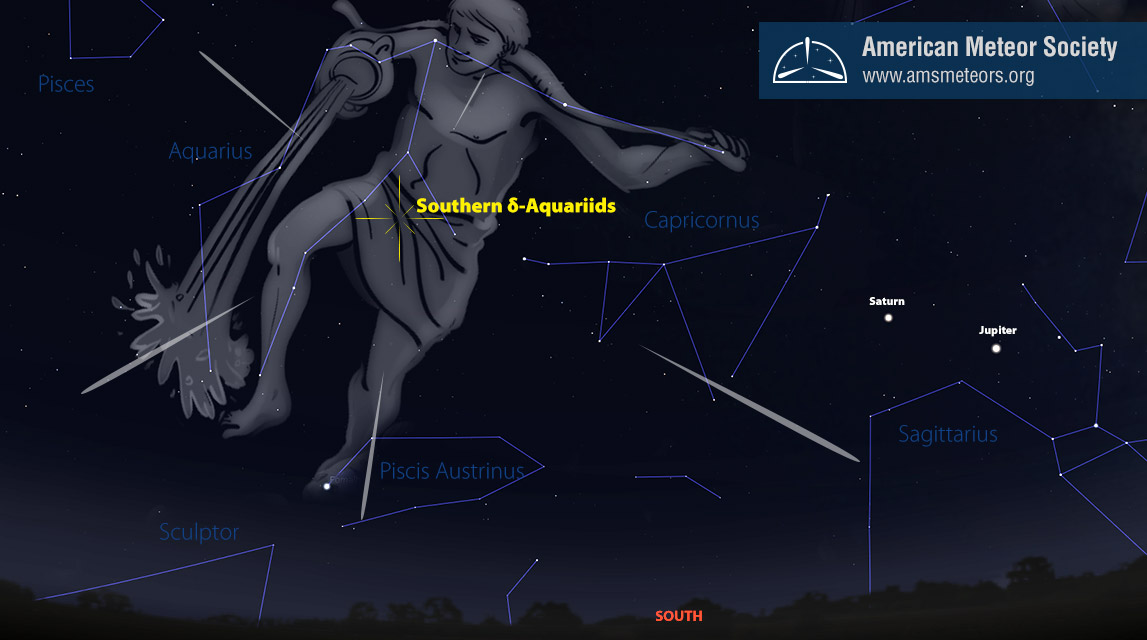One good thing about a Perseid maximum with lunar interference is that it guarantees that two weeks prior that the Southern delta Aquariids (SDA) will peak under good conditions. Such is the case in 2020 when the last quarter moon will diminish the Perseid peak. The SDA’s will peak on July 29th with a waxing gibbous moon setting just as the SDA radiant culminates in the southern sky. Now this display will not replace the mighty Perseids as it is much weaker, especially as seen from mid-northern latitudes. But it is a nice warmup to the Perseids as the southern sky is full of active radiants this time of year. The strongest of these by far are the Southern delta Aquariids.
These meteors were first noticed in the mid-19th century. It is still not precisely known what is the parent object of these meteors. The orbits of these meteors display a similarity to that of the Daylight Arietids and the Quadrantids. It is possible that all three of these displays are produced by remnants of comet C/1490 Y1. These remnants include comet 96P/Machholz and the asteroid known as 2003 EH1.
The Earth first encounters debris associated with the SDA’s on July 19th. Rates increase steadily until the maximum is reached 10 days later. The decline from maximum is far less steep as these meteors can still be seen through August 18th. Some studies even stated that the SDA’s remain active until September. The problem with that though is that rates at this time are so low that sporadic interlopers, imitating SDA’s, exceed any true SDA’s during this period.
When the SDA’s first start appearing, the radiant lies on the Aquarius/Capricornus border. For the next 10 nights it moves eastward at just under 1 degree per night and ends up just west of the 3rd magnitude star known as Skat (delta Aquarii) on the night of maximum activity. As August arrives the radiant continues through central Aquarius until it crosses the border into Cetus near the time of the Perseid maximum.

To view the SDA’s in 2020, it would be best to watch as close to July 29th as possible. It would also be wise to wait until the moon has set to see the most activity. Once August arrives, the moon will remain above the horizon most of the night making observations difficult at best.
For observers located at mid-northern latitudes, the radiant will not rise higher than 30 degrees. This means that half of the activity will be missed even under perfect conditions. The further south you go in the northern hemisphere, the better you chances will be to see more activity from this source. The best location lies at latitude 16 south, where the radiant passes directly overhead. Observers further south than this will have slightly worse viewing conditions, but still much better than a majority of the northern hemisphere.
Your plan to see these meteors would be to observe between the hours of 2-4am local summer time. It doesn’t matter greatly where you live longitudinally, as the radiant reaches its maximum altitude near the same time. If you do not observe daylight saving time, then 1-3am would be optimal. I would suggest facing due south about halfway up in the sky. Don’t stand and watch as you will quickly tire. Lie in a comfortable lounge chair for at least an hour. Since meteor activity is notoriously “clumpy”, there will be peaks and valleys of activity continuously throughout the night. If you watch for a period shorter than 60 minutes, you may find yourself viewing in the middle of a slump of activity. Don’t bother trying to view these meteors prior to 10pm as the source of these meteors lies below the horizon until then.
You can help expand our knowledge of these meteors by recording the activity you see. The basic information would include your location, time of the session, type of meteor you see (SDA vs. Sporadic), your sky condition (usually expressed as limiting magnitude of the faintest star you can see), and any obstacles in your field of view expressed in percentage of obscuration. If you really feel motivated you can include the time of each meteor and its magnitude, color, and appearance of a persistent train. You can even try to identify some of the minor showers that are active at the same time as the SDA’s. You can share your results by filling out an online visual meteor form at the International Meteor Organization on line report form.
If your skies happen to be cloudy on the night of July 28/29, don’t worry as the SDA’s produce good rates for several nights centered on July 29th. Good luck!




 You saw something bright and fast? Like a huge shooting star? Report it: it may be a fireball.
You saw something bright and fast? Like a huge shooting star? Report it: it may be a fireball.  You counted meteors last night? Share your results with us!
You counted meteors last night? Share your results with us!  You took a photo of a meteor or fireball? You have a screenshot of your cam? Share it with us!
You took a photo of a meteor or fireball? You have a screenshot of your cam? Share it with us!  You caught a meteor or fireball on video? Share your video with us!
You caught a meteor or fireball on video? Share your video with us!